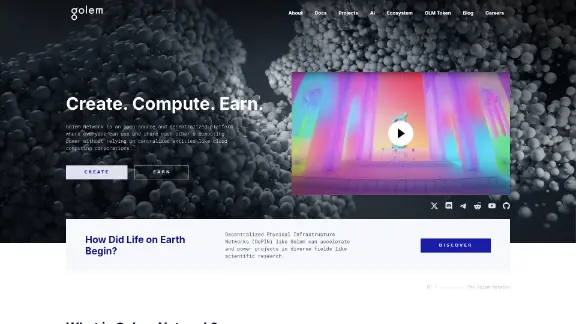Golem (GLM)
Golem Network is a, open-source, decentralized computing platform designed to create a peer-to-peer marketplace for distributed computing resources. This platform is particularly focused on catering to the needs of the artificial intelligence (AI) industry, by providing the necessary computing power through a decentralized model. Users on the Golem Network can directly engage with each other to exchange computational resources using GLM tokens, which serve as the native currency of the platform.
The ecosystem of Golem Network
Decentralized computing platform

| Ticker | GLM |
| Category | Artificial Intelligence (AI) |
| Website | https://golem.network/ |
| @golemproject | |
| Telegram | golemnetworkproject |
| https://www.reddit.com/r/GolemProject | |
| Contract Addresses | |
|---|---|
| ethereum | 0x7d...29 Copied! Copied! |
| energi | 0xf3...a8 Copied! Copied! |
The Golem Network enables users to share and access idle computing resources, effectively creating a decentralized platform for computing. This platform is designed to break down large computational tasks into smaller subtasks, which are then distributed across multiple providers. This distribution allows for parallel processing, significantly enhancing the efficiency and speed of completing complex computations. By leveraging the collective power of distributed resources, Golem facilitates a scalable solution for high-demand computational tasks.
Peer-to-peer marketplace
At the heart of Golem Network is a peer-to-peer marketplace where users can transact directly with one another. This marketplace is where Requestors—users in need of computational resources—can post tasks and offer a bid in GLM tokens for the completion of these tasks. Providers—users with idle computing resources—can then accept these tasks and complete them in exchange for GLM tokens. This model creates a seamless and decentralized environment for the exchange of computational power, benefiting both sides of the marketplace.
Understanding GLM
The role of GLM in Golem Network
GLM, or Golem Network Token, is the native cryptocurrency that powers the Golem Network. It acts as the primary medium of exchange within the platform, facilitating transactions between Requestors and Providers. Requestors use GLM to pay for the computational tasks they need, while Providers earn GLM as compensation for offering their computing power. This token-based system ensures a fluid and efficient marketplace, incentivizing participation and resource sharing.
Obtaining and using GLM
Users interested in engaging with the Golem Network can acquire GLM tokens through various cryptocurrency exchanges. Once obtained, these tokens can be used to pay for computational tasks or earned by providing computing resources. This dual functionality of GLM within the Golem ecosystem underscores its importance as a driving force for the network's operations.
Participating in Golem Network
Becoming a Requestor or Provider
Individuals interested in joining the Golem Network can do so as either a Requestor or a Provider. Requestors are users who require computational resources for their tasks, while Providers are those who offer their idle computing power to complete these tasks. By participating in the network, users can either fulfill their computational needs or monetize their unused computing resources.
